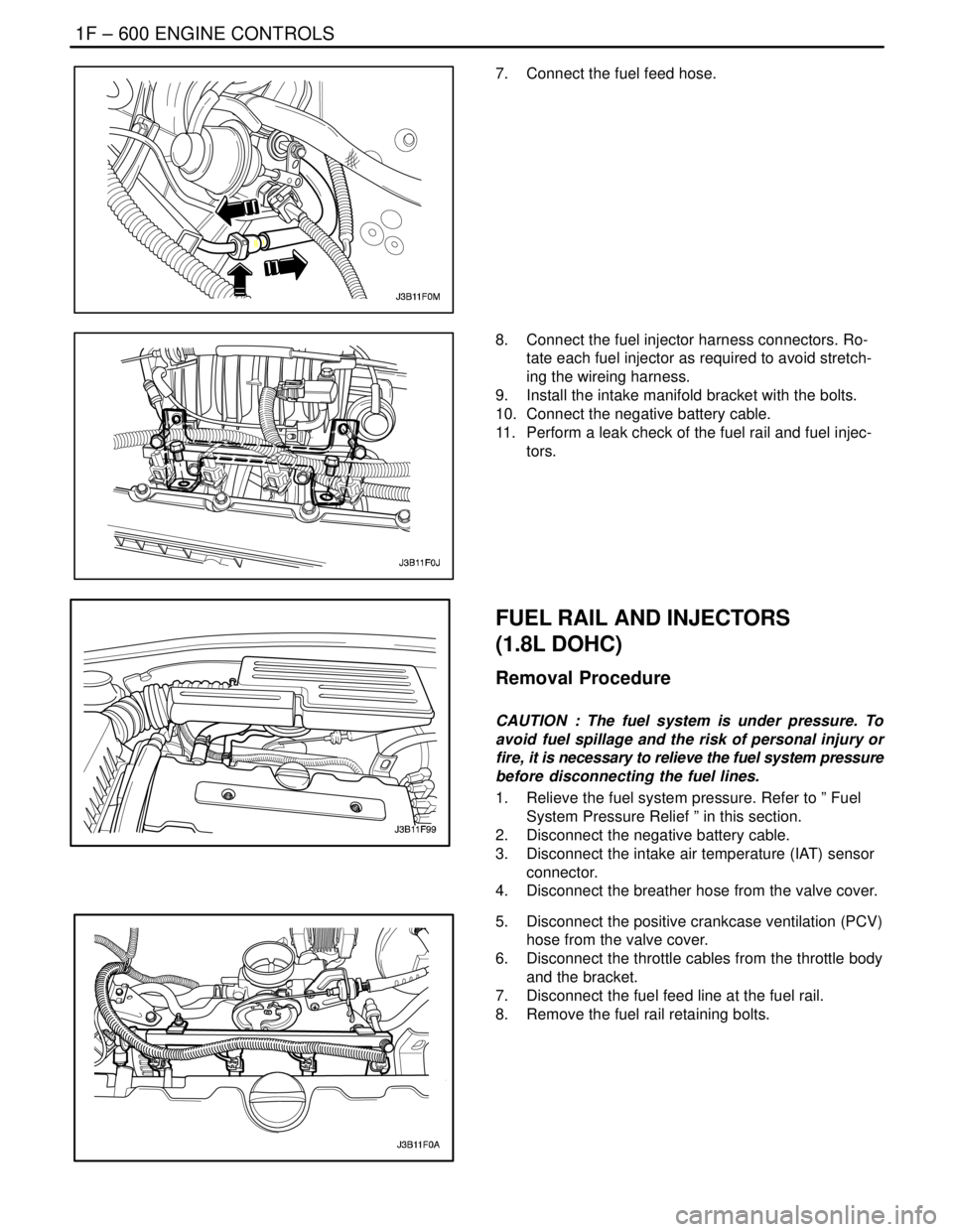2004 DAEWOO NUBIRA check engine
[x] Cancel search: check enginePage 838 of 2643

1F – 592IENGINE CONTROLS
DAEWOO V–121 BL4
StepNo Yes Value(s) Action
91. Repair or replace any ignition system compo-
nents as needed.
2. Perform an emission test.
Does the vehicle pass the emission test?–System OK–
101. Inspect for vacuum leaks.
2. Inspect the catalytic converter for contamina-
tion.
3. Inspect for carbon buildup on the throttle body
and the throttle plate and inside the engine.
Remove with a top engine cleaner.
4. Check the Exhaust Gas Recirculation (EGR)
valve to make sure it opens.
5. Check for proper Positive Crankcase Ventila-
tion (PCV) operation.
Are all checks and needed repairs complete?–System OK–
DIESELING, RUN–ON
Definition : An engine continues to run after the ignition switch is turned OFF.
Step
ActionValue(s)YesNo
1Were the Important Preliminary Checks performed?–Go toStep 2Go to
”Important Pre-
liminary
Checks”
2Does the engine run smoothly after the ignition
switch is turned OFF?–Go toStep 3Go toStep 4
31. Check the ignition switch and the ignition
switch adjustment.
2. Replace the ignition switch if needed.
Is the repair complete?–System OK–
41. Check the evaporative emission system.
2. Check for leaking fuel injectors.
3. Check the Idle Air Control (IAC) valve opera-
tion.
4. Inspect for vacuum leaks.
5. Check for the proper base idle setting.
Are all checks and repairs complete?–System OK–
Page 839 of 2643

ENGINE CONTROLS 1F – 593
DAEWOO V–121 BL4
BACKFIRE
Definition : Fuel ignites in the intake manifold, or in the ex-
haust system, making a loud popping noise.Important : Before diagnosing the symptom, check ser-
vice bulletins for updates.
Step
ActionValue(s)YesNo
1Were the Important Preliminary Checks performed?–Go toStep 2Go to
”Important Pre-
liminary
Checks”
21. Inspect for crossed or crossfiring ignition wires.
2. Check the ignition system output voltage for all
cylinders using a spark tester.
3. Inspect the spark plugs for excessive wear,
burned electrodes, improper gap, or heavy de-
posits..
Is the problem found?–Go toStep 3Go toStep 4
3Repair or replace any ignition system components
as needed.
Is the repair complete?–System OK–
41. Check the fuel system operation.
2. Check the fuel injectors by performing an injec-
tor diagnosis.
Is the problem found?–Go toStep 5Go toStep 6
5Repair or replace any fuel system components as
needed.
Is the repair complete?–System OK–
61. Inspect the Exhaust Gas Recirculation (EGR)
gasket for a leak or a loose fit.
2. Check the EGR valve for proper operation.
3. Inspect the intake manifold and the exhaust
manifold for a casting flash.
Is the problem found?–Go toStep 7Go toStep 8
7Repair or replace any components as needed.
Is the repair complete?–System OK–
81. Inspect the timing belt for proper installation
and tension.
2. Check the engine compression.
3. Inspect the intake manifold gasket and the ex-
haust manifold gasket for leaks.
4. Check for sticking or leaking valves.
5. Repair or replace any components as needed.
Are all checks and corrections complete?–System OK–
Page 842 of 2643

1F – 596IENGINE CONTROLS
DAEWOO V–121 BL4
7. Connect the fuel pump harness connector.
8. Connect the fuel vapor line.
9. Connect the fuel tank filler tube.
10. Connect the fuel tank vent tube.
11. Install the fuel tank filler tube clamp at the fuel tank.
12. Install the front muffler. Refer to Section 1G, Ex-
haust System
13. Connect the negative battery cable.
14. Fill the fuel tank.
15. Perform a leak check of the fuel tank and the fuel
line connections.
FUEL PUMP
Removal Procedure
CAUTION : The fuel system is under pressure. To
avoid fuel spillage and the risk of personal injury or
fire, it is necessary to relieve the fuel system pressure
before disconnecting the fuel lines.
1. Relieve the fuel system pressure.
1) Remove the fuel cap.
2) Remove fuel pump fuse Ef18 from the engine
fuse block.
3) Start the engine and allow the engine to stall.
4) Crank the engine for an additional 10 seconds.
2. Disconnect the negative battery cable.
3. Remove the rear seat. Refer to Section 9H, Seats.
4. Remove the fuel pump access cover.
5. Disconnect the electrical connector at the fuel
pump assembly.
6. Disconnect the fuel outlet line.
7. Disconnect the fuel tank return line.
Page 843 of 2643

ENGINE CONTROLS 1F – 597
DAEWOO V–121 BL4
8. Turn the lock ring counterclockwise to clear the
tank tabs.
9. Remove the fuel pump assembly from the tank.
Installation Procedure
1. Clean the gasket mating surface on the fuel tank.
2. Position the new gasket in place.
3. Install the fuel pump into the fuel tank in the same
location as removed for ease of line and connector
installation.
4. Position the lock ring in place and turn it clockwise
until it contacts the tank stop.
5. Connect the fuel pump assembly connector.
6. Install the fuel pump outlet line.
7. Install the fuel tank return line.
8. Install the fuel pump access cover.
9. Connect the negative battery cable.
10. Perform an operational check of the fuel pump.
11. Install the rear seat. Refer to Section 9H, Seats.
FUEL FILTER
Removal Procedure
CAUTION : The fuel system is under pressure. To
avoid fuel spillage and the risk of personal injury or
fire, it is necessary to relieve the fuel system pressure
before disconnecting the fuel lines.
1. Relieve the fuel system pressure. Refer to ” Fuel
System Pressure Relief ” in this section.
2. Disconnect the negative battery cable.
3. Remove the fuel filter mounting bracket assembly
bolt.
4. Remove the fuel filter cover.
5. Disconnect the inlet/outlet fuel lines by moving the
line connector lock forward and pulling the hose off
of the fuel filter tube.
Page 846 of 2643

1F – 600IENGINE CONTROLS
DAEWOO V–121 BL4
7. Connect the fuel feed hose.
8. Connect the fuel injector harness connectors. Ro-
tate each fuel injector as required to avoid stretch-
ing the wireing harness.
9. Install the intake manifold bracket with the bolts.
10. Connect the negative battery cable.
11. Perform a leak check of the fuel rail and fuel injec-
tors.
FUEL RAIL AND INJECTORS
(1.8L DOHC)
Removal Procedure
CAUTION : The fuel system is under pressure. To
avoid fuel spillage and the risk of personal injury or
fire, it is necessary to relieve the fuel system pressure
before disconnecting the fuel lines.
1. Relieve the fuel system pressure. Refer to ” Fuel
System Pressure Relief ” in this section.
2. Disconnect the negative battery cable.
3. Disconnect the intake air temperature (IAT) sensor
connector.
4. Disconnect the breather hose from the valve cover.
5. Disconnect the positive crankcase ventilation (PCV)
hose from the valve cover.
6. Disconnect the throttle cables from the throttle body
and the bracket.
7. Disconnect the fuel feed line at the fuel rail.
8. Remove the fuel rail retaining bolts.
Page 848 of 2643

1F – 602IENGINE CONTROLS
DAEWOO V–121 BL4
9. Connect the PCV hose to the valve cover.
10. Connect the breather hose to the valve cover.
11. Connect the IAT sensor connector.
12. Connect the negative battery cable.
13. Perform a leak check of the fuel rail and fuel injec-
tors.
ENGINE COOLANT TEMPERATURE
SENSOR (1.4L/1.6L DOHC)
Removal Procedure
1. Relieve the coolant system pressure.
2. Disconnect the negative battery cable.
3. Disconnect the engine coolant temperature (ECT)
sensor connector.
Notice : Take care when handling the engine coolant tem-
perature sensor. Damage to the sensor will affect the prop-
er operation of the fuel injection system.
4. Remove the ECT sensor
Installation Procedure
1. Install the engine coolant temperature (ECT) sen-
sor.
Tighten
Tighten the engine coolant temperature (ECT) sensor
to 17.5 NSm (13 lb–ft).
2. Connect the ECT sensor connector.
3. Connect the negative battery cable.
ENGINE COOLANT TEMPERATURE
SENSOR (1.8L DOHC)
Removal Procedure
1. Relieve the coolant system pressure.
2. Disconnect the negative battery cable.
3. Disconnect the engine coolant temperature (ECT)
sensor connector.
Notice : Take care when handling the engine coolant tem-
perature sensor. Damage to the sensor will affect the prop-
er operation of the fuel injection system.
4. Remove the ECT sensor from the electronic ignition
(EI) system ignition coil adapter.
Page 852 of 2643

1F – 606IENGINE CONTROLS
DAEWOO V–121 BL4
7. Connect the TP sensor connector and the IAC
valve connector.
8. Connect the coolant hoses to the throttle body.
9. Connect the vacuum hoses to the throttle body.
Important : Make sure the throttle/cruise control cables
do not hold the throttle open. With the engine off, check to
see that the accelerator pedal is free.
10. Connect the throttle cable.
11. Install the air intake tube.
12. Connect the breather hose to the valve cover.
13. Connect the IAT sensor connector.
14. Connect the negative battery cable.
15. Fill the cooling system.
FRONT HEATED OXYGEN SENSOR
(HO2S1) (1.4L/1.6L DOHC)
Removal Procedure
1. Disconnect the negative battery cable.
Notice : The oxygen sensor uses a permanently attached
pigtail and connector. This pigtail should not be removed
from the oxygen sensor. Damage or removal of the pigtail
or the connector could affect proper operation of the oxy-
gen sensor. Take care when handling the oxygen sensor.
Do not drop the oxygen sensor.
2. Disconnect the front heated oxygen sensor
(HO2S1) connector.
Notice : The oxygen sensor may be difficult to remove
when engine temperature is below 48°C (120°F). Exces-
sive force may damage threads in the exhaust manifold.
3. Carefully remove the HO2S1 from the exhaust
manifold.
Installation Procedure
Important : A special anti–seize compound is used on the
oxygen sensor threads. This compound consists of a liq-
uid graphite and glass beads. The graphite will burn away,
but the glass beads will remain, making the sensor easier
to remove. New or service sensors will already have the
compound applied to the threads. If a sensor is removed
from any engine and if for any reason it is to be reinstalled,
the threads must have anti–seize compound applied be-
fore reinstallation.
1. Coat the threads of the HO2S1 with an anti–seize
compound, if needed.
2. Install the HO2S1 into the exhaust manifold.
Tighten
Tighten the oxygen sensor to 42 NSm (31 lb–ft).
3. Connect the HO2S1 connector.
4. Connect the negative battery cable.
Page 856 of 2643

1F – 610IENGINE CONTROLS
DAEWOO V–121 BL4
Notice : Do not use methyl ethyl ketone because it can
damage the parts.
6. Clean the IAC valve O–ring seal area, the pintle
valve seat, and the air passage with a suitable fuel
system cleaner.
Installation Procedure
Important : If installing a new IAC valve, be sure to re-
place it with an identical part. The IAC valve pintle shape
and diameter are designed for the specific application.
Measure the distance between the tip of the IAC valve
pintle and the mounting flange. If the distance is greater
than 1.1 inches (28 mm), use finger pressure to slowly re-
tract the pintle. The force required to retract the pintle will
not damage the IAC valve. The purpose of the 1.1–inch
(28–mm) setting is to prevent the IAC pintle from bottom-
ing out on the pintle seat. This 1.1–inch (28–mm) setting
is also an adequate setting for controlled idle on a restart.
1. Lubricate a new O–ring with engine oil. Install the
new O–ring onto the valve.
2. Install the IAC valve into the throttle body.
3. Install the IAC valve retaining bolts.
Tighten
Tighten the idle air control valve retaining bolts to 3
NSm (27 lb–in).
4. Connect the IAC valve connector.
5. Install the air intake resonator.
6. Connect the negative battery cable.
7. Start the engine and check for the proper idle
speed.
MANIFOLD ABSOLUTE PRESSURE
SENSOR (1.4L/1.6L DOHC)
Removal Procedure
1. Disconnect the negative battery cable.
2. Remove the manifold Absolute pressure (MAP)
sensor electrical connector.
3. Disconnect the MAP sensor vacuum hose.
4. Remove the MAP sensor bolt.
5. Remove the MAP sensor.